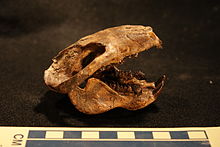This article includes a list of general references, but it lacks sufficient corresponding inline citations. (October 2013) |
| Cimolodonta | |
|---|---|

| |
| Skull of Meniscoessus | |
| Scientific classification | |
| Domain: | Eukaryota |
| Kingdom: | Animalia |
| Phylum: | Chordata |
| Class: | Mammalia |
| Order: | †Multituberculata |
| Suborder: | †Cimolodonta McKenna, 1975 |
| Superfamilies | |
Cimolodonta is a clade of multituberculate mammals that lived from the Cretaceous to the Eocene. They probably lived something of a rodent-like existence until their ecological niche was assumed by true rodents. The more basal multituberculates are found in a different suborder, "Plagiaulacida", a paraphyletic group containing all non cimolodontan multituberculates.
Cimolodonta is apparently a natural (monophyletic) suborder. Remains have been identified from across the Northern Hemisphere. They first appeared during the Aptian, and completely replaced the more primitive plagiaulacidans by the early Late Cretaceous.[2] The taxon is recognized as the informal Paracimexomys group and the superfamilies Djadochtatherioidea, Taeniolabidoidea, and Ptilodontoidea. Additionally, and of uncertain affinities, are the families Cimolomyidae, Boffiidae, Eucosmodontidae, Kogaionidae, Microcosmodontidae and the two genera Uzbekbaatar and Viridomys. More precise placement of these types awaits further discoveries and analysis.
- ^ T. H. Rich, P. A. Vickers-Rich, T. F. Flannery, B. P. Kear, D. J. Cantrill, P. Komarower, L. Kool, D. Pickering, P. Trusler, S. Morton, N. A. Van Klaveren, E. M. G. Fitzgerald (2009). "An Australian Multituberculate and Its Palaeobiogeographic Implications". Acta Palaeontologica Polonica. 54 (1): 1-6. doi:10.4202/app.2009.0101.
{{cite journal}}: CS1 maint: multiple names: authors list (link) - ^ Weaver, Lucas N.; Wilson, Gregory P.; Krumenacker, L. J.; Mclaughlin, Kayla; Moore, Jason R.; Varricchio, David J. (2019-03-04). "New multituberculate mammals from the mid-Cretaceous (lower Cenomanian) Wayan Formation of southeastern Idaho and implications for the early evolution of Cimolodonta". Journal of Vertebrate Paleontology. 39 (2): e1604532. doi:10.1080/02724634.2019.1604532. ISSN 0272-4634. S2CID 196655261.